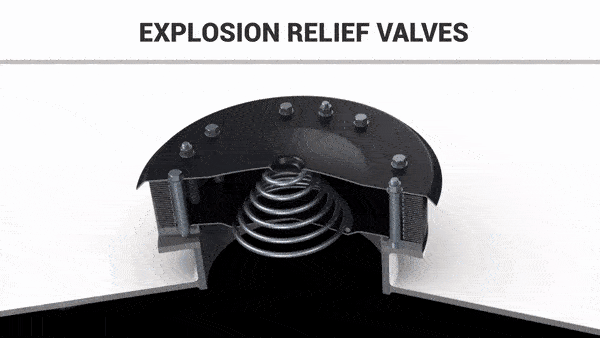What has happened here?
The video shows an installation consisting of two tanks connected with a channel. The dust explosion occurs in the right-hand tank, which is protected with an explosion relief valve (the dark, round element on the top of the tank. At this point, the red HRD cylinder is not active. The video shows our test tank featuring several protection systems installed simultaneously – during the test, only one of those systems is active). The explosion then travels through the channel and reaches the left-hand side, smaller, tank, where another explosion occurs. This tank is protected with an explosion relief panel which opens and thus releases the effects of the explosion into the surrounding environment.
What is worth noting?
▶ The transfer of the explosion from the right to the left tank was possible, because the channel connecting the two tanks did not have the so-called explosion isolation system. Usually, this situation would not be allowed. Despite this, it is one of the most common mistakes we see at manufacturing plants.
▶ It is also worth comparing the effect provided by the explosion relief valve (right-hand side) with that of the decompression panel (left-hand side). Clearly, the valve, unlike the panel, does not allow the explosion to be released to the outside environment. Exhaust gases is all we see near the valve. Additionally, the valve releases only residual, i.e. safe, pressure. In the case of the decompression panel, both the flames as well as the high pressure are released to the outside environment. As you can imagine, this can burn people close to the panel, cause damage to adjacent equipment and be a source of airborne dust ignition. This in turn leads to a very dangerous secondary explosion, which has been the cause of a complete destruction of many plants. We have described several such accidents in the case studies below:
▶ Due to the above-mentioned reasons as well as the applicable regulations, decompression panels must not be used indoors. Panels with a decompression channel are an exception to this rule. However, to be able to use this option, a number of conditions must be met, which is why this solution is rarely used. We have addressed this topic in detail in the article titled Can decompression panels be used indoors?
▶ A relief valve can be used indoors (provided the cubature of the room is at least 15 times greater than the volume of the protected equipment).

What is the best choice – a decompression panel or a decompression valve?
First of all, it is the safety device provider who should answer this question. Based on our experience, we can tell that whenever a customer attempts to choose safety devices on its own, problems are likely to occur. This is nothing to be held against such a customer, as no-one expects an installation user to be an expert on everything. I, for example, am familiar with explosion safety but I have no knowledge of many other areas, says Zbigniew Wolff, WOLFF GROUP explosion protection expert.
What sort of the problems can occur? As Mr. Wolff continues: in the best case scenario, this will be pointed out to us by a representative of the insurance company or the person drawing up the documentation for the explosion protection system. This is common but not certain. This is because these people, despite their best intentions, do not have the right tools to verify whether a given safety device is suitable or not. Therefore, in most cases they only assess, whether the equipment has the required safety devices installed, not whether or not these devices are a good match..
Examples of common errors
For example, in the case of decompression panels or explosion relief valves, it is very important to calculate the minimum decompression area. If the area is too small, the safety device will be ineffective.
Whereas in the case of an explosion isolation device used in a channel connecting two pieces of equipment, the place of its installation is very important. Obviously, there is some margin for error. However, if you place the isolation device too close to the piece of equipment where the explosion takes place, it may not be able to act fast enough. Keep in mind that we are talking about response times measured in milliseconds..
If, on the other hand, you install the explosion isolation device too far, a detonation will occur in the channel connecting the two pieces of equipment and, as a result, the duct will be torn apart. This is because an explosion travelling through a channel is getting more powerful with every meter. At some point, this phenomenon accelerates dramatically and the pressure reaches a peak value of several dozen bar. No duct is strong enough to withstand that. It will be torn open, which is very dangerous in itself. But that’s not all. If combustible dust lingers around, and we are well aware that this is not an exceptional situation, it will be sent in the air by the pressure and vibrations from the installation. This will create an explosive atmosphere that can easily be ignited by the explosion released into the environment.
The phenomenon of detonation in a channel. Admittedly, this case involves gases but it is a very similar situation in the case of dusts. Importantly, you’ll also find a video comparing both phenomena.
Consequences of errors
If errors are found in the explosion protection system installed on a given piece of equipment, it will be necessary to modify or replace the safety devices. This will be a small price to pay as compared to the consequences you will have to face in the event the safety devices fail to act as expected at the time of an explosion. I know of many such cases. For example, at least two disastrous errors were made in one of the plants that resulted in a complete destruction of the entire facility. I encourage you to study this example, as we have included a video showing a reconstruction of events which explains this phenomenon and also provides food for thought. At this point, I will only tell you that the errors consisted in poorly chosen decompression panels (of insufficient area) and a lack of isolation. Both errors pertained to an off-site dust extraction system. Despite this, the explosion penetrated into the production hall, where a secondary explosion took place.
Let us get back to the main topic – I would like to emphasize that both of the safety devices can be very effective. They can, as long as they are selected correctly and installed along with an explosion isolation system. Whether we decide to use decompression panels or an explosion relief valve, we always have to use these safety devices along with an isolation system that will prevent the explosion from reaching adjacent equipment. I will explain why this is so important in the following section. At this point I will only say that no safety device is guaranteed to be effective if there is no explosion isolation system in place.
However, if I were to list the most important advantages and limitations of explosion relief panels and valves, I would point out the following:
DECOMPRESSION PANELS
- Limitation: not suitable for use indoors or outdoors when the outlet from the panels is directed towards other equipment or places where people may be present (footpaths, car parks, roads, etc.). It is necessary to demarcate a danger zone in which there must be no other equipment or people. It is a single-use solution.
- Advantage: often the cheapest option
EXPLOSION RELIEF VALVE
- Limitation: higher purchase price
- Advantage: suitable for indoor use with room cubature less than 15 times the volume of the protected equipment. Not subject to most of the limitations applicable to decompression panels.
Why we absolutely must prevent secondary explosions?
No explosion isolation system means that flames and residual pressure can spread to adjacent equipment and thus cause so-called secondary explosions. Such an explosion is characterised by a much greater explosive force and dynamics…such which render safety devices useless. In other words, if we assume, while designing the safety devices, that the explosion will start at atmospheric pressure – which is a common practice – then the propagation of the explosion from one piece of equipment to another will lead to a new explosion, which will be initiated at a much higher pressure value. As a result, the maximum explosion pressure and the reduced explosion pressure values increase.
It should be explained here that the reduced explosion pressure (P red) is the pressure after tripping of the safety devices. It must be lower than the structural strength of the protected equipment, so that it does not explode. In most cases, the structural strength (P struct.) of equipment is within the 0.2-0.6 bar range. The maximum explosion pressure (P max), for most dusts, is within the 3-10 bar range. If we assume that the reduced explosion pressure is 0.1 bar and the maximum explosion pressure is 10 bar, the safety devices would have to ensure a 100-fold reduction of the explosion pressure in the equipment.
The higher initial pressure of the secondary explosion is only one of the problems. When designing an explosion protection system, we assume that we are dealing with a point source of ignition. Meanwhile, we are dealing with a high-energy ignition source, i.e. a fireball which has been pushed into the equipment. This change from the initial assumptions causes the explosion to occur with greater intensity, which may also be the cause of the failure of the protection system. An incomplete explosion protection system we should add, because we are analysing a case without an explosion isolation system. While the ATEX Directive clearly indicates that equipment subject to an explosion hazard should be protected with explosion relief or suppression devices used in combination with an explosion isolation device.
This is the first reference to explosion suppression. This is an alternative to decompression or explosion relief systems. We will discuss suppression systems in a separate article. At this point, it is only worth clarifying that explosion suppression is the most versatile method of protection, which has none the above-mentioned limitations typical of decompression panels or relief technology in general. Unlike other safety devices, an explosion suppression system prevents an explosion from developing, i.e. the explosion is suppressed at its source. Therefore, we do not have to deal with the consequences of a fire in the equipment after the explosion. There is also no need to demarcate a danger zone around the protected equipment. Furthermore, HRD cylinders used for explosion suppression purposes can also serve as the explosion isolation system.
Explosive dusts in commonly used in industry
Food and agricultural products
- cotton
- albumen
- fibre / cellulose
- hops
- sugar
- cork tree
- gluten
- tea
- cocoa
- semolina
- coffee
- lactose
- alfalfa
- wood meal
- oat flour/meal
- wheat flour/meal
- soybean flour/meal
- milk powder
- spices
- whey
- linseed
- lemon peel
- rice starch
- corn starch
- wheat starch
- potato starch
- malt
- dried fruit and vegetables
- tapioca
- tobacco
- oat grain
Metals
- aluminium
- bronze
- zinc
- magnesium
Chemicals
- anthraquinone
- sodium ascorbate
- aspirin
- ammonium nitrate
- adipic acid
- ascorbic acid
- maltodextrin
- calcium acetate
- paraformaldehyde
- sulphur
- lead stearate
- sodium stearate
- calcium stearate
Solid fuels and their derivatives
- biomass
- coke
- carbon black
- brown coal
- charcoal
- hard coal
Plastics
- urea formaldehyde
- melamine
- polyvinyl derivatives
- polyacrylamide (PAM)
- Poly (methyl acrylate)
- polyacrylonitrile (PAN)
- polypropylene (PP)
- polyethylene (PE)
- epoxy resin
- phenolic resin
- melamine resin





